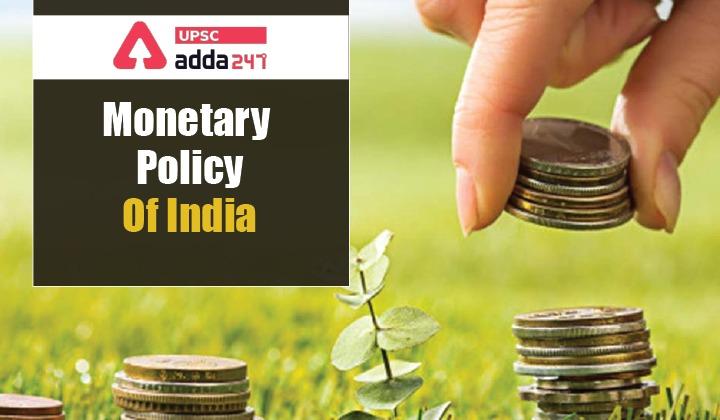Table of Contents
Relevance
- GS Paper 3: Monetary Policy in India is a relevant topic for UPSC Paper 3 as it covers the regulatory measures taken by the Reserve Bank of India to control money supply, stabilize inflation, manage interest rates, and ensure overall economic stability. Understanding the objectives, tools, and implementation of monetary policy is crucial for candidates preparing for the UPSC exam to have a comprehensive understanding of India’s economic policies and their impact on the country’s financial system.
What is monetary policy?
- Monetary policy is the utilization of monetary instruments by the central bank to regulate various factors such as interest rates, money supply, and credit availability.
- The primary objective of monetary policy is to achieve the broader goals of economic policy.
- The Reserve Bank of India (RBI) is responsible for conducting monetary policy in India.
- The authority and mandate to conduct monetary policy are explicitly mentioned in the Reserve Bank of India Act, 1934.
- Through monetary policy, the RBI aims to ensure price stability, promote economic growth, and maintain financial stability.
- The RBI uses various tools such as repo rate, reverse repo rate, and open market operations to influence money supply and interest rates.
- Monetary policy decisions are taken by the RBI’s Monetary Policy Committee (MPC), which meets at regular intervals to assess economic conditions and formulate appropriate policy measures.
- Effective implementation of monetary policy requires close monitoring of economic indicators, inflation trends, and domestic and international factors affecting the economy.
- The RBI’s monetary policy plays a crucial role in shaping India’s overall economic environment, influencing investment decisions, and maintaining stability in the financial system.
Goal of monetary policy
- The primary objective of monetary policy is to maintain price stability while keeping in mind the objective of growth.
- To maintain price stability, inflation should be within limits. The amended RBI Act provides for the inflation target to be set by the Government of India, in consultation with the Reserve Bank, once in every five years.
- In May 2016, the Reserve Bank of India (RBI) Act, 1934 was amended to provide a statutory basis for the implementation of the flexible inflation-targeting framework.
Contractionary and expansionary monetary policy
- Contractionary monetary policy is a monetary measure that means a reduction in the rate of monetary expansion by a central bank. It is a microeconomic tool designed to combat rising inflation or other economic distortions created by central banks or government interventions.
- Expansionary monetary policy is the polar opposite of contractionary monetary policy. Expansionary policy is a loose form of macroeconomic policy that seeks to encourage economic growth. It is part of the general policy prescription of Keynesian economics. It is used during economic slowdowns and recessions in order to moderate the downside of economic cycles.
Instruments of monetary policy
There are several direct and indirect instruments that are used for implementing monetary policy.
-
- Repo Rate: The (fixed) interest rate at which the Reserve Bank provides overnight liquidity to banks against the collateral of government and other approved securities under the liquidity adjustment facility (LAF).
- Reverse Repo Rate: The (fixed) interest rate at which the Reserve Bank absorbs liquidity, on an overnight basis, from banks against the collateral of eligible government securities under the LAF.
- Liquidity Adjustment Facility (LAF): The LAF consists of overnight as well as term repo auctions. Progressively, the Reserve Bank has increased the proportion of liquidity injected under fine-tuning variable rate repo auctions of range of tenors. The aim of term repo is to help develop the inter-bank term money market, which in turn can set market-based benchmarks for pricing of loans and deposits, and hence improve the transmission of monetary policy. The Reserve Bank also conducts variable interest rate reverse repo auctions, as necessitated under the market conditions.
- Marginal Standing Facility (MSF): A facility under which scheduled commercial banks can borrow an additional amount of overnight money from the Reserve Bank by dipping into their Statutory Liquidity Ratio (SLR) portfolio up to a limit at a penal rate of interest. This provides a safety valve against unanticipated liquidity shocks to the banking system.
- Corridor: The MSF rate and reverse repo rate determine the corridor for the daily movement in the weighted average call money rate.
- Bank Rate: It is the rate at which the Reserve Bank is ready to buy or rediscount bills of exchange or other commercial papers. The Bank Rate is published under Section 49 of the Reserve Bank of India Act, 1934. This rate has been aligned to the MSF rate and, therefore, changes automatically as and when the MSF rate changes alongside policy repo rate changes.
- Cash Reserve Ratio (CRR): The average daily balance that a bank is required to maintain with the Reserve Bank as a share of such percent of its Net demand and time liabilities (NDTL) that the Reserve Bank may notify from time to time in the Gazette of India.
- Statutory Liquidity Ratio (SLR): The share of NDTL that a bank is required to maintain in safe and liquid assets, such as unencumbered government securities, cash and gold. Changes in SLR often influence the availability of resources in the banking system for lending to the private sector.
- Open Market Operations (OMOs): These include both, outright purchase and sale of government securities, for injection and absorption of durable liquidity, respectively.
- Market Stabilisation Scheme (MSS): This instrument for monetary management was introduced in 2004. Surplus liquidity of a more enduring nature arising from large capital inflows is absorbed through sale of short-dated government securities and treasury bills. The cash so mobilized is held in a separate government account with the Reserve Bank.
| UPSC Related Links | |||
| Reforms in Urban Planning Capacity in India | Trade and Development Report 2021 | Trade and Development Report 2021 | Euro Green Bond |
| The History of Backward Classes Commission And the Sub-Categorisation of OBCs | Elderly Population Of India: Expert Committee On Longevity Finance | Impact of US Inflation in India | Pradhan Mantri Awas Yojana- Gramin |
| India Rejects WTO Draft on Fishery Subsidy | Supreme Court Allows Legal Sand Mining in Rajasthan | ADR Report on Political Donations | Delhi Declaration on Afghanistan |
| Follow US |
|
| UPSC Govt Jobs UPSC Current Affairs UPSC Judiciary PCS Download Adda 247 App here to get the latest updates |





 TSPSC Group 1 Question Paper 2024, Downl...
TSPSC Group 1 Question Paper 2024, Downl...
 TSPSC Group 1 Answer key 2024 Out, Downl...
TSPSC Group 1 Answer key 2024 Out, Downl...
 UPSC Prelims 2024 Question Paper, Downlo...
UPSC Prelims 2024 Question Paper, Downlo...




